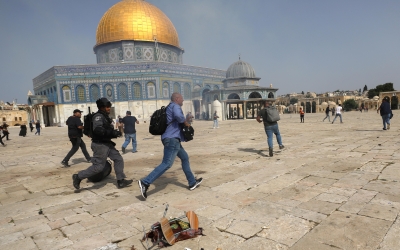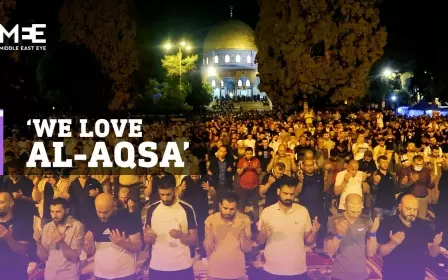How Israeli raid on al-Aqsa Mosque could constitute a war crime
If attacks by Israeli security forces on al-Aqsa Mosque continue, international attention may begin to focus on the question of whether they would constitute a war crime.
Attacks on cultural sites during armed conflicts are considered to be a war crime under a number of international laws and treaties.
The Rome Statute of 1998, which established the International Criminal Court (ICC) at The Hague, declared that anyone "intentionally directing attacks against buildings dedicated to religion, education, art, science or charitable purposes [or] historic monuments" was committing a war crime.
There would not need to be significant damage - the statute criminalises the attack and not its consequences.
The ICC announced earlier this year that it was mounting an investigation into crimes allegedly committed by both Israelis and Palestinians in the occupied Palestinian territories.
Palestine has signed the Rome Statute. The Israeli government also signed up, but then decided it did not wish to be a state party, and denies the ICC has any right to investigate alleged crimes it has committed.
In addition to the Rome Statute, the 1954 Hague Convention - the first international treaty focusing entirely on the protection of sites of cultural significance during armed conflict - obliges occupying forces to protect cultural heritage.
The convention - which has been signed by Israel - is intended to protect culturally significant sites from destruction, looting or unnecessary military use.
Underpinning the convention is the principle that "damage to cultural property belonging to any people whatsoever means damage to the cultural heritage of all mankind".
The convention has become part of international customary law, meaning that its provisions are binding on all parties to any conflict, but no national government has ever been prosecuted for breaching it.
A further convention, the World Heritage Convention, followed in 1972. Under this, the Old City of Jerusalem and its walls were designated as a world heritage site at the request of Jordan.
In 1982, the site was placed on Unesco's endangered list as a result of tensions within the city.
Finally, in 2017, United Nations Security Council resolution 2347 condemned "the unlawful destruction of cultural heritage … notably by terrorist groups".
The Taliban, therefore, was committing an offence when it destroyed the monumental statues of Buddha in the Bamiyan valley in Afghanistan in March 2001.
So too was the Islamic State (IS) group when it laid waste to the ancient city of Palmyra in Syria and several other sites between 2014 and 2016.
In 2016, Ahmad al-Faqi al-Mahdi, a leading member of a group associated with al-Qaeda, was jailed for nine years by the ICC after admitting to the war crime of intentionally directing an attack against historic monuments.
He was one of a group of men who had destroyed nine mausoleums and a mosque in Timbuktu in Mali, four years earlier.
Another case which includes charges arising out of the destruction at Timbuktu is pending at The Hague.
And in January last year, then-US President Donald Trump was warned that he would be committing a war crime if he followed through on his threat - made over Twitter - to target culturally significant sites in Iran.
He had warned the United States had selected 52 sites in Iran, "some at a very high level & important to Iran & Iranian culture, and those targets, and Iran itself, WILL BE HIT VERY FAST AND VERY HARD".
The Pentagon quickly distanced itself from the threat, pledging it would "follow the laws of armed conflict".
The Hague Convention
The need for special protection of sites of religious or cultural significance was recognised following the widespread destruction of the First World War, but the first convention designed to protect them, the Roerich Pact, was only ratified by 10 states in the Americas, and nowhere else.
The need for an international treaty became more pressing during the Spanish Civil War, and the Hague Convention was drafted in 1938, but its ratification was prevented by the Second World War.
That war saw the Nazis systematically pillaging and destroying sites in Russia and eastern Europe, the UK's Royal Air Force dropping incendiary bombs on the German city of Lubeck, much of which was medieval and built of wood, and Germany retaliating with the so-called Baedeker Blitz, using the travel guidebook to select five historic English cities for aerial bombardment.
By 1956, when the Hague Convention came into force, there was a fear that nuclear war could bring far greater destruction than ever seen before.
A second protocol to the Hague Convention, giving even greater protection to cultural property, was adopted at a diplomatic conference in the city in 1999. This protocol has not been signed by Israel.
This article is available in French on Middle East Eye French edition.
Middle East Eye propose une couverture et une analyse indépendantes et incomparables du Moyen-Orient, de l’Afrique du Nord et d’autres régions du monde. Pour en savoir plus sur la reprise de ce contenu et les frais qui s’appliquent, veuillez remplir ce formulaire [en anglais]. Pour en savoir plus sur MEE, cliquez ici [en anglais].






